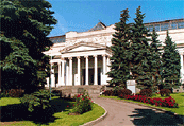 pirogov national medical surgical center
pirogov national medical surgical centernational center for researh and treatment of autoimmune diseases new jersey center for quality of life and health outcome research |
international symposium stem cell transplantation in multiple sclerosis: sharing the experience |
 |
 |
 |
 |
 |
 |
 |
 |
 |
 |
 |
 |
 |
 |
 |
| About Moscow |
|
Moscow, Russia 
Moscow is the capital of Russia, the country's largest city, its major political, industrial and cultural center. First tribes appeared on the territory of the future Moscow in the Neolithic period. The first reference to Moscow, as a town, is found in the old manuscript of 1147. In late 15th century, during the reign of Ivan III, Moscow becomes the capital of Russia. Moscow Kremlin, which was built in the beginning of the 15 century, is a symbol of that era. Today Moscow is one of the world biggest megapolises and the biggest city in Europe. Its population is about 10 million people. According to assessments by the World Tourism Organization, Russia is rated 15th in the world in terms of the number of foreign visitors. Every year Russia greets about 17.5 million guests, and Moscow is one of the most popular Russian cities to visit. Moscow is a Russian Mecca for tourists. It is a unique city: its architecture combines the features of both Oriental and Western cultures. The Moscow region has one of the largest historical/cultural potential in the country. More than 200 sights of the city are brought in to the UNO register. The Kremlin 
The Kremlin is the symbol of Russia and the main tourist attraction of Moscow. Once the residence of the Tsars and Patriarchs, today it is one of the biggest architectural ensembles in the world, which is included in the UNESCO list. During this tour you will see the chambers and cathedrals inside the fortress. You will visit some of the churches in the area of the Kremlin, walk by the Tsar's Bell and the Tsar's Cannon and see the unique and priceless collections of the Armory Chamber. Novodevichy Convent 
Novodevichy Convent is one of the Moscow's most attractive monasteries. Novodevichy, or "New Maidens" Convent in English was founded in a suburb of Moscow in 1524 to commemorate the liberation of Smolensk from the Lithuanians in 1514. The convent resembles a miniature Kremlin by its architectural style. Many of the city's monasteries served as retirement homes for royal and noble women, who either chose or were forced to take the veil and remain in the safety of the convents for the rest of their lives. The Tsars and the supreme feudal nobility showed a great interest in the Novodevichy convent, rendering it all possible financial and legal support. The convent has also been a burial place for famous persons in Russian history. Pushkin Museum of Fine Arts 
The Pushkin Museum of Fine Arts is Moscow's equivalent to St. Petersburg's enormous Hermitage Museum, and boasts an impressive collection ranging from Roman antiquities to canvasses by Gauguin. State Tretyakov Gallery 
The State Tretyakov Gallery presents the best collection of Russian fine arts in the world, from the ancient times to the contemporaries. The museum was founded in 1856 by the merchant P. Tretyakov, who donated his collection to the city. Today the museum houses a collection of more than 130,000 artworks. Kuskovo Estate 
Kuskovo Estate is a unique opportunity for those who want to be involved in the atmosphere of 18th century. This was a luxurious summer residence of Sheremetyev earls, designed for magnificent receptions, crowded performances, celebrations and festivities. About 20 unique architectural monuments have survived till the present. Among them are the Palace, Grotto, Big Stoned Greenhouse, and an ancient church. Another landmark of this estate is a perfectly preserved regular French park with marble sculptures, ponds and original pavilions. The Palace of Kuskovo is somehow a theater where everything is designed to amaze and delight the spectators. The names and decorations of each hall are unique but altogether they form integral composition where various kinds of art, every masterpiece and decorative detail submit to the main artistic idea. Nowadays museum has one of the biggest specialized collections of ceramics and glass from various countries from ancient times till the present day. It features about 30.000 exhibits of Russian and foreign art, including remarkable examples of Italian majolica, Venetian, English and Russian glass, Meisen, Sevres and Oriental chinaware. But the main pride of the museum is the collection of chinaware from Russian manufacturers from the 18th century. |
|
© KMart |
(last update) 28/10/2009 |